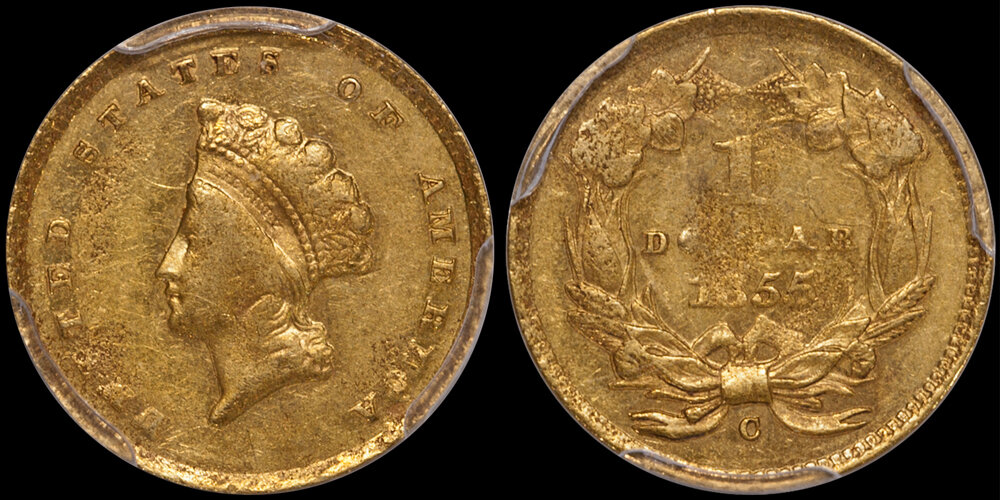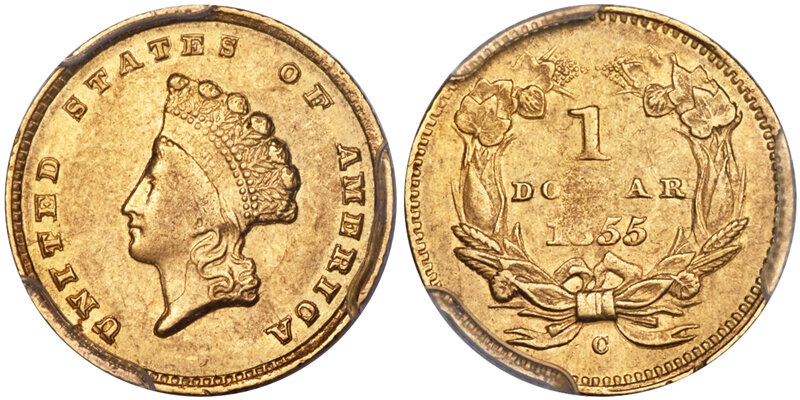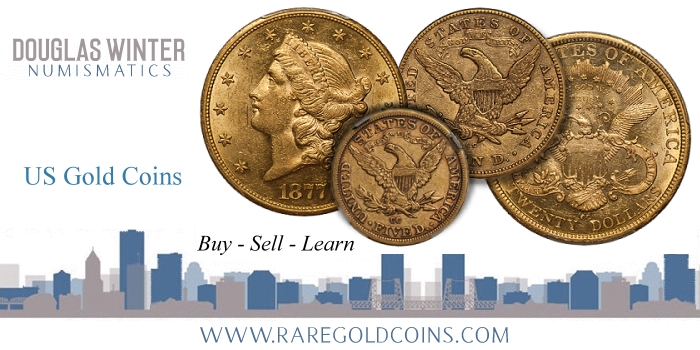By Doug Winter – RareGoldCoins.com ……
CoinWeek Content Partner
I can’t think of a single branch mint gold coin that has performed as poorly from a price perspective as the 1855-C gold dollar. Back around 2005 through 2008, these routinely traded in AU55 for $10,000-12,000 USD. Today, certain pieces in AU55 holders now bring only $5,000-5,500.

1855-C $1.00 PCGS AU55 CAC. Images courtesy Douglas Winter Numismatics (DWN) unless otherwise noted
Why did this important one-year type coin drop so much in value? The answer is not as cut-and-dry as it might seem.
Before I answer this question, let’s take a quick look at the background of the 1855-C gold dollar.
As with the 1855-O, 1855-D, and 1856-S, this is an important one-year type. Being the only Type Two gold dollar from the Charlotte Mint should make this a pretty in-demand issue, right? Furthermore, this issue has a reasonably low mintage of 9,803 with an estimated 250-300 examples known in all grades.
But there is an inherent problem with this issue: it is easily amongst the worst-struck of all Federal gold coins, regardless of mint. The typical 1855-C gold dollar is difficult to grade, even for a trained professional. At least 75% of all known pieces are found on poorly prepared planchets, and essentially every known 1855-C shows incomplete detail at the centers. You have to grade an 1855-C based on its luster and not its detail.
This is all well and good, except what happens when people start stripping the vast majority of examples and simulating mint luster through chemical brightening agents?
The answer is that you get Extremely Fine 1855-C gold dollars that magically gradeflate into AU55s. A coin that is seemingly rare suddenly becomes “common”.

1855-C NGC AU55. Image courtesy Heritage Auctions (HA)
Here is an image of an NGC AU55 that brought a low price of $5,040 when sold as Lot 3763 in a February 2019 Heritage sale.

1855-C PCGS AU55. Image courtesy Heritage Auctions (HA)
Now compare this with the PCGS/CAC AU55 that brought $17,684 when sold as Lot 15908 in a Heritage April 2017 sale.
This is not an indictment of NGC’s grading as there are a number of PCGS-graded examples of this date that I don’t care for, and there are some NGC-graded 1855-C examples that I really like.
An important point to consider is that there are two varieties of 1855-C gold dollar. The scarcer of the two, Winter-1, tends to come flatly struck at the centers but is fairly sharp at the borders and is found on generally good-quality planchets. The more common Winter-2 tends to come a bit better detailed but has more noticeable clashmarks and is almost always found on terrible planchets. Given the choice between the two, most collectors would rather have a nice example of the first variety than of the second.
Since the market has determined that a nice 1855-C gold dollar—in virtually any grade—is worth at least two times (if not even three times) more than a crappy one, it seems to me that something needs to be done to help a collector determine which is which.
I’ve got a suggestion: why not have the grading services distinguish between the Winter-1 and Winter-2 varieties; sort of like they do with 1922-D and 1922 “Plain” Pennies? PCGS and NGC could take all 1855-C gold dollars and re-holder them as “sharp strike” and “weak strike” or “choice planchet” and “typical planchet”.
Of course, this may never happen so it is up to the collector to become familiar with the appearance characteristics of this issue.
If you are a collector seeking a nice 1855-C, you’ll want to wait for a coin that has the original color. You’ll likely not find one with choice surfaces, so you’ll have to make the determination about how much planchet disturbance you can handle. I’d say that holding out for a PCGS/CAC coin makes the most sense; you’ll have to figure out how much of a premium you’ll want to pay for such a coin.

* * *
About Doug Winter
 Doug has spent much of his life in the field of numismatics; beginning collecting coins at the age of seven, and by the time he was 10 years old, buying and selling coins at conventions in the New York City area.
Doug has spent much of his life in the field of numismatics; beginning collecting coins at the age of seven, and by the time he was 10 years old, buying and selling coins at conventions in the New York City area.
In 1989, he founded Douglas Winter Numismatics, and his firm specializes in buying and selling choice and rare US Gold coins, especially US gold coins and all branch mint material.
Recognized as one of the leading specialized numismatic firms, Doug is an award-winning author of over a dozen numismatic books and the recognized expert on US Gold. His knowledge and an exceptional eye for properly graded and original coins have made him one of the most respected figures in the numismatic community and a sought-after dealer by collectors and investors looking for professional personalized service, a select inventory of impeccable quality, and fair and honest pricing. Doug is also a major buyer of all US coins and is always looking to purchase collections both large and small. He can be reached at (214) 675-9897.
Doug has been a contributor to the Guidebook of United States Coins (also known as the “Redbook”) since 1983, Walter Breen’s Encyclopedia of United States and Colonial Coins, Q. David Bowers’ Encyclopedia of United States Silver Dollars and Andrew Pollock’s United States Pattern and Related Issues
In addition, he has authored 13 books on US Gold coins including:
- Gold Coins of the New Orleans Mint: 1839-1909
- Gold Coins of the Carson City Mint: 1870 – 1893
- Gold Coins of the Charlotte Mint: 1838-1861
- Gold Coins of the Dahlonega Mint 1838-1861
- The United States $3 Gold Pieces 1854-1889
- Carson City Gold Coinage 1870-1893: A Rarity and Condition Census Update
- An Insider’s Guide to Collecting Type One Double Eagles
- The Connoisseur’s Guide to United States Gold Coins
- A Collector’s Guide To Indian Head Quarter Eagles
- The Acadiana Collection of New Orleans Coinage
- Type Three Double Eagles, 1877-1907: A Numismatic History and Analysis
- Gold Coins of the Dahlonega Mint, 1838-1861: A Numismatic History and Analysis
- Type Two Double Eagles, 1866-1876: A Numismatic History and Analysis
Finally, Doug is a member of virtually every major numismatic organization, professional trade group and major coin association in the US.





Great article — especially for a collector who is rather new. I enjoy that it discusses a dimension of valuation unseasoned collectors may not realize has a tremendous bearing upon valuation.